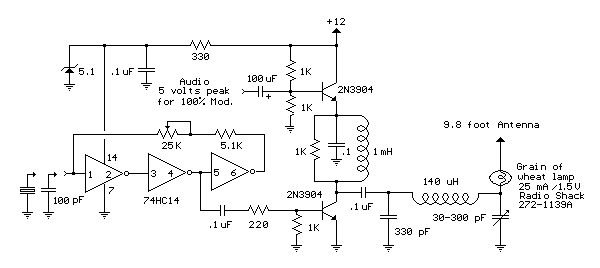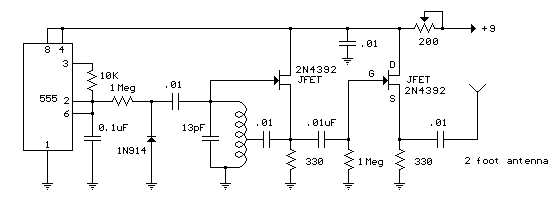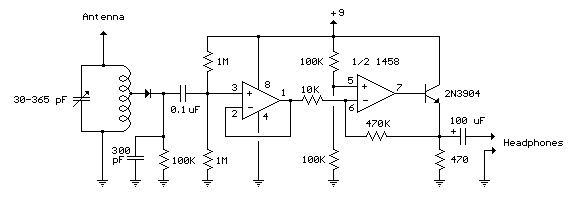|

Micro Power AM Broadcast
Transmitter

In this circuit, a 74HC14
hex Schmitt trigger inverter is used as a square wave oscillator to drive
a small signal transistor in a class C amplifier configuration. The
oscillator frequency can be either fixed by a crystal or made adjustable
(VFO) with a capacitor/resistor combination. A 100pF capacitor is used in
place of the crystal for VFO operation. Amplitude modulation is
accomplished with a second transistor that controls the DC voltage to the
output stage. The modulator stage is biased so that half the supply
voltage or 6 volts is applied to the output stage with no modulation. The
output stage is tuned and matched to the antenna with a standard variable
30-365 pF capacitor. Approximately 20 milliamps of current will flow in
the antenna lead (at frequencies near the top of the band) when the output
stage is optimally tuned to the oscillator frequency. A small 'grain of
wheat' lamp is used to indicate antenna current and optimum settings. The
140 uH inductor was made using a 2 inch length of 7/8 inch (OD) PVC pipe
wound with 120 turns of #28 copper wire. Best performance is obtained near
the high end of the broadcast band (1.6 MHz) since the antenna length is
only a very small fraction of a wavelength. Input power to the amplifier
is less than 100 milliwatts and antenna length is 3 meters or less which
complies with FCC rules. Output power is somewhere in the 40 microwatt
range and the signal can be heard approximately 80 feet. Radiated power
output can be approximated by working out the antenna radiation resistance
and multiplying by the antenna current squared. The radiation resistance
for a dipole antenna is 80*pi^2*(length/wavelength)^2 which yields about
0.2 ohms for a 3 meter dipole at a frequency of 1.6 MHz. Radiated power at
20 milliamps is about I^2 * R = 80 microwatts and for a grounded system
with a single element whip antenna, the radiated power is about half that,
or 40 microwatts.
Original scheme edited by Bill
Bowden, http://www.bowdenshobbycircuits.info

FM Beacon Broadcast
Transmitter (88-108 MHz)

This circuit will
transmit a continuous audio tone on the FM broadcast band (88-108 MHz)
which could used for remote control or security purposes. Circuit draws
about 30 mA from a 6-9 volt battery and can be received to about 100
yards. A 555 timer is used to produce the tone (about 600 Hz) which
frequency modulates a Hartley oscillator. A second JFET transistor buffer
stage is used to isolate the oscillator from the antenna so that the
antenna position and length has less effect on the frequency. Fine
frequency adjustment can be made by adjusting the 200 ohm resistor in
series with the battery. Oscillator frequency is set by a 5 turn tapped
inductor and 13 pF capacitor. The inductor was wound around a #8 X 32 bolt
(about 3/16 diameter) and then removed by unscrewing the bolt. The
inductor was then streached to about a 3/8 inch length and tapped near the
center. The oscillator frequency should come out somewhere near the center
of the band (98 MHz) and can be shifted higher or lower by slightly
expanding or compressing the inductor. A small signal diode (1N914 or
1N4148) is used as a varactor diode so that the total capacity in parallel
with the inductor varies slightly at the audio rate thus causing the
oscillator frequency to change at the audio rate (600 Hz). The ramping
waveform at pins 2 and 6 of the timer is applied to the reversed biased
diode through a large (1 Meg) resistor so that the capacitance of the
diode changes as the ramping voltage changes thus altering the frequency
of the tank circuit. Alternately, an audio signal could be applied to the
1 Meg resistor to modulate the oscillator but it may require an additional
pullup resistor to reverse bias the diode. The N channel JFET transistors
used should be high frequency VHF or UHF types (Radio Shack #276-2062
MPF102) or similar.

Original scheme edited by Bill
Bowden, http://www.bowdenshobbycircuits.info
Simple Op-Amp Radio

This is basically a
crystal radio with an audio amplifier which is fairly sensitive and
receives several strong stations in the Los Angeles area with a minimal 15
foot antenna. Longer antennas will provide a stronger signal but the
selectivity will be worse and strong stations may be heard in the
background of weaker ones. Using a long wire antenna, the selectivity can
be improved by connecting it to one of the taps on the coil instead of the
junction of the capacitor and coil. Some connection to ground is required
but I found that standing outside on a concrete slab and just allowing the
long headphone leads to lay on the concrete was sufficient to listen to
the local news station (KNX 1070). The inductor was wound with 200 turns
of #28 enameled copper wire on a 7/8 diameter, 4 inch length of PVC pipe,
which yields about 220 uH. The inductor was wound with taps every 20 turns
so the diode and antenna connections could be selected for best results
which turned out to be 60 turns from the antenna end for the diode. The
diode should be a germanium (1N34A type) for best results, but silicon
diodes will also work if the signal is strong enough. The carrier
frequency is removed from the rectified signal at the cathode of the diode
by the 300 pF cap and the audio frequency is passed by the 0.1uF capacitor
to the non-inverting input of the first op-amp which functions as a high
impedance buffer stage. The second op-amp stage increases the voltage
level about 50 times and is DC coupled to the first through the 10K
resistor. If the pairs of 100K and 1 Meg resistors are not close in value
(1%) you may need to either use closer matched values or add a capacitor
in series with the 10K resistor to keep the DC voltage at the transistor
emitter between 3 and 6 volts. Another approach would be to reduce the
overall gain with a smaller feedback resistor (470K). High impedance
headphones will probably work best, but walkman stereo type headphones
will also work. Circuit draws about 10 mA from a 9 volt source. Germanium
diodes (1N34A) types are available from Radio Shack, #276-1123.
Original scheme edited by Bill
Bowden, http://www.bowdenshobbycircuits.info

AM/FM/SW active antenna


This circuit shows an active antenna that can be used
for AM, FM, and shortwave (SW). On the shortwave band this active antenna
is comparable to a 20 to 30 foot wire antenna. This circuit is designed to
be used on receivers that use untuned wire antennas, such as inexpensive
units and car radios. L1 can be selected for the application. A 470uH coil
works on lower frequencies ( AM ). For shortwave, try a 20uH coil. The
unit can be powered by a 9 volt battery. If a power supply is used, bypass
the power supply with a .04uF capacitor to prevent noise pickup. The
antenna used on this circuit is a standard 18" telescoping type.
Output is taken from jack J1 and run to the input on the receiver.
Ham radio Data Center - free schematics | 73s.eu - Free Ham Radio Social Network | Free HAM Directory | About me | Acronyms | CW | Data Sheets | Docs | Download | E-mail | HOME | Ham projects | Hobby circuits | Photo galery | PIC | QTH photos |
Sign in my guestbook | View my guestbook ]
© 2001 - YO5OFH, Csaba Gajdos
|



